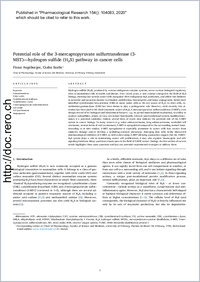Potential role of the 3-mercaptopyruvate sulfurtransferase (3-MST)—hydrogen sulfide (H2S) pathway in cancer cells
- Augsburger, Fiona Chair of Pharmacology, Faculty of Science and Medicine, University of Fribourg, Fribourg, Switzerland
- Szabo, Csaba Chair of Pharmacology, Faculty of Science and Medicine, University of Fribourg, Fribourg, Switzerland
-
01.04.2020
Published in:
- Pharmacological Research. - 2020, vol. 154, p. 104083
English
Hydrogen sulfide (H2S), produced by various endogenous enzyme systems, serves various biological regulatory roles in mammalian cells in health and disease. Over recent years, a new concept emerged in the field of H2S biology, showing that various cancer cells upregulate their endogenous H2S production, and utilize this mediator in autocrine and paracrine manner to stimulate proliferation, bioenergetics and tumor angiogenesis. Initial work identified cystathionine-beta-synthase (CBS) in many tumor cells as the key source of H2S. In other cells, cystathionine-gamma-lyase (CSE) has been shown to play a pathogenetic role. However, until recently, less attention has been paid to the third enzymatic source of H2S, 3-mercaptopyruvate sulfurtransferase (3-MST), even though several of its biological and biochemical features - e.g. its partial mitochondrial localization, its ability to produce polysulfides, which, in turn, can induce functionally relevant posttranslational protein modifications - makes it a potential candidate. Indeed, several lines of recent data indicate the potential role of the 3-MST system in cancer biology. In many cancers (e.g. colon adenocarcinoma, lung adenocarcinoma, urothelial cell carcinoma, various forms of oral carcinomas), 3-MST is upregulated compared to the surrounding normal tissue. According to in vitro studies, 3-MST upregulation is especially prominent in cancer cells that recover from oxidative damage and/or develop a multidrug- resistant phenotype. Emerging data with newly discovered pharmacological inhibitors of 3-MST, as well as data using 3-MST silencing approaches suggest that the 3-MST/H2S system plays a role in maintaining cancer cell proliferation; it may also regulate bioenergetic and cell-signaling functions. Many questions remain open in the field of 3-MST/cancer biology; the last section of current article highlights these open questions and lays out potential experimental strategies to address them.
- Faculty
- Faculté des sciences et de médecine
- Department
- Médecine 3ème année
- Language
-
- English
- Classification
- Biological sciences
- License
- License undefined
- Identifiers
-
- RERO DOC 328426
- DOI 10.1016/j.phrs.2018.11.034
- Persistent URL
- https://folia.unifr.ch/unifr/documents/308379
Statistics
Document views: 76
File downloads:
- sza_prt.pdf: 460
